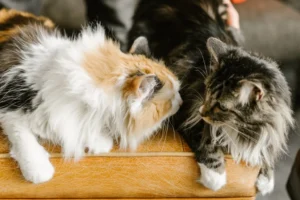Cats are fascinating creatures, known for their independence, agility, and mysterious aura. One aspect of felines that often puzzles pet owners is the amount of bacteria present in their mouths. But why do cats have so much bacteria in their mouths?
Cats have a high amount of bacteria in their mouths primarily due to their grooming habits and the structure of their teeth and saliva composition.
1. How do cats use grooming to contribute to the bacteria in their mouths?
Cats are meticulous groomers, spending a significant amount of time each day cleaning themselves. This grooming behavior plays a vital role in the buildup of bacteria in their mouths. When cats lick themselves, they transfer bacteria from their fur to their mouths, introducing a range of microorganisms into their oral cavity. Additionally, cats often groom each other as a form of social bonding, further spreading bacteria between individuals. The constant grooming not only keeps their fur clean but also inadvertently populates their mouths with a diverse array of bacteria.
2. What role do the teeth of a cat play in the bacteria present in their mouths?
A cat’s teeth not only aid in their hunting and eating habits but also significantly impact the bacteria present in their mouths. Cats have sharp, pointed teeth that are designed for tearing flesh and crushing bones. The structure of their teeth provides crevices and gaps where bacteria can easily accumulate and flourish. Unlike animals with flatter teeth surfaces that may not trap bacteria as easily, cats’ teeth are ideal breeding grounds for various microorganisms. This dental environment, combined with their grooming habits, contributes to the high levels of bacteria found in a cat’s mouth.
Additional unique insight: When cats groom themselves, they also ingest a significant amount of hair. This hair can act as a substrate for bacteria to adhere to and thrive, further increasing the bacterial diversity in their mouths.
Remember, while it’s normal for cats to have bacteria in their mouths, it’s essential to maintain their oral health by regularly brushing their teeth and providing them with appropriate dental care to keep any potential issues at bay.
3. How does a cat’s saliva composition lead to an increase in bacteria?
Let’s dive into why cats have so much bacteria in their mouths. It all comes down to their saliva composition. Cats have enzymes in their saliva that are specifically designed to break down protein-rich foods. This means that their saliva has a higher pH level compared to humans, creating an ideal environment for bacteria to thrive in. The enzymes in their saliva provide a perfect breeding ground for bacteria, leading to a higher concentration of it in their mouths.
4. Can the bacteria in a cat’s mouth be harmful to humans?
Now, you might be wondering if these bacteria pose a risk to us humans. The good news is that the bacteria typically found in a cat’s mouth are specific to felines and are unlikely to cause harm to humans. However, it’s essential to practice good hygiene after interacting with your furry friend to minimize any potential risks. *Avoid letting your cat lick your face *or any open wounds, and always wash your hands after handling them. By taking these simple precautions, you can enjoy the company of your cat without worrying about any harmful bacteria transfer.
Here’s key insight: Did you know that cats have a natural resistance to many harmful bacteria found in their mouths? This means that they are less likely to get sick from the bacteria present in their mouths, a fascinating evolutionary adaptation that sets them apart from other animals.
5. How do cats benefit from the bacteria in their mouths?
Believe it or not, cats actually benefit from the bacteria in their mouths! These tiny organisms play a crucial role in helping to keep your feline friend healthy. The bacteria act as a natural defense system, protecting cats from harmful pathogens by outcompeting them. This symbiotic relationship helps maintain a healthy balance in your cat’s mouth, preventing infections and promoting overall oral health. So, next time your kitty gives you a smooch with those bacteria-filled kisses, just remember it’s all in the name of keeping them healthy!
6. What can pet owners do to reduce the bacteria in their cat’s mouth?
As much as bacteria are beneficial for cats, it’s essential to keep their oral hygiene in check. One simple way to reduce the bacteria in your cat’s mouth is by regularly brushing their teeth. Yes, you heard that right – brushing your cat’s teeth can help remove plaque and reduce the buildup of harmful bacteria. Additionally, providing dental treats or toys designed to promote good oral health can also contribute to keeping those bacteria levels in check. Remember, a little effort in maintaining your cat’s oral hygiene can go a long way in keeping them healthy and happy.
Extra Tip: Consider adding dental water additives to your cat’s water bowl. These additives can help reduce bacteria in your cat’s mouth and promote better oral health. Just make sure to consult with your veterinarian before making any changes to your cat’s dental care routine.
(External Resource: American Veterinary Dental College)
7. Are there any natural remedies to maintain a healthy balance of bacteria in a cat’s mouth?
Looking for natural ways to keep your feline friend’s mouth bacteria in check? Well, you’re in luck! Probiotics are a fantastic option to support a healthy balance of bacteria in your cat’s mouth. These beneficial bacteria can help maintain a harmonious environment in your cat’s oral cavity. Coconut oil is another excellent natural remedy that can be used to promote oral health in cats. It has antimicrobial properties that can help control harmful bacteria. Additionally, make sure your cat has access to clean, fresh water at all times, as proper hydration is crucial for overall health, including oral health. Remember, a happy mouth leads to a happy cat!
8. Interesting Fact: The rough texture of a cat’s tongue not only aids in grooming but also helps to remove food particles and bacteria from their teeth.
Here’s a fascinating tidbit for you: a cat’s tongue is not only helpful for grooming but also serves as a built-in cleaning tool for their teeth. The rough texture of a cat’s tongue acts like a natural toothbrush, removing food particles and bacteria that may linger on their teeth. This unique feature showcases the clever design of our feline friends, allowing them to maintain dental hygiene in a rather inventive way. So, next time you see your cat grooming, remember that they are not just primping their fur but also taking care of their pearly whites!
Alex, a passionate animal lover, has experience in training and understanding animal behavior. As a proud pet parent to two dogs and three cats, he founded AnimalReport.net to share insights from animal experts and expand his knowledge of the animal kingdom.









